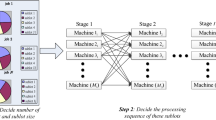Abstract
Economic lot-scheduling problem (ELSP) has been studied since the 1950’s. ELSP deals with the scheduling of the production of several items on a single facility in a cyclical pattern. The facility can only produce one single item at a time, and there is a set-up cost and set-up time associated with each item. Because of the rapid development of many emerging markets nowadays, many common items are produced in different places in order to satisfy the demands in different markets. This becomes the multi-facilities ELSP problems. In ELSP problems, it is known that if more items types to be produced by the facility, the production frequency of each item type will increase because of the balancing of the production rate and the demand rate. Consequently, the number of set-up time and set-up cost increases accordingly. Thus, reallocating the common items, which can be produced in any facilities, to be produced only on certain facility can certainly reduce the number of production frequency, and lead to lower related costs. The objective of this paper is to propose an optimization methodology combining Integer Programming and Genetic Algorithm to solve multi-facility ELSP problems. This paper proposes to divide the main problem into a master problem and sub-problems, which are solved by Integer Programming and Genetic Algorithm respectively. To demonstrate the significance of reallocating the common items and aggregating them to produce in certain facility, several models have been designed and tested. The comparison of the models demonstrates the reduction of the costs benefited by result of common items reallocation.
Similar content being viewed by others
References
Akrami B., Karimi B., Moattar Hosseini S. M. (2006) Two metaheuristic methods for the common cycle economic lot sizing and scheduling in flexible flow shops with limited intermediate buffers: The finite horizon case. Applied Mathematics and Computation 183(1): 634–645
Bomberger E. E. (1966) A dynamic programming approach to a lot size scheduling problem. Management Science 12(11): 778–784
Brander P., Segerstedt A. (2009) Economic lot scheduling problems incorporating a cost of using the production facility. International Journal of Production Research 47(13): 3611–3624
Chan F. T. S., Chan H. K. (2004) Analysis of dynamic control strategies of an FMS under different scenarios. Robotics and Computer Integrated Manufacturing 20(5): 423–437
Chan, H. K., & Chung, S. H. (2009). Genetic approach to solve economic lot-scheduling problem. Proceedings of the 6th international conference on digital enterprise technology (DET 2009), December 14–16, 2009, Hong Kong, pp. 885–895.
Chang Y.-J., Yao M.-J. (2008) Solving the economic lot scheduling problem with identical facilities in parallel using genetic algorithms. Journal of the Chinese Institute of Industrial Engineers 25(2): 91–104
Chatfield D. C. (2007) The economic lot scheduling problem: A pure genetic search approach. Computers and Operations Research 34(10): 2865–2881
Dobson G. (1987) The economic lot-scheduling problem: Achieving feasibility using time-varying lot sizes. Operations Research 35(5): 764–770
Elmaghraby S. (1978) The economic lot scheduling problem (ELSP): Review and extension. Management Science 24(6): 587–598
Guner Goren H., Tunali S., Jans R. (2010) A review of applications of genetic algorithms in lot sizing. Journal of Intelligent Manufacturing 21(4): 575–590
Hennet J.-C. (2001) A common cycle approach to lot-scheduling in multistage manufacturing systems. Production Planning and Control 12(4): 362–371
Hsu W.-L. (1983) On the general feasibility test of scheduling lot sizes for several products on one machine. Management Science 29(1): 93–105
Jenabi M., Fatemi Ghomi S. M. T., Torabi S. A., Karimi B. (2007) Two hybrid meta-heuristics for the finite horizon ELSP in flexible flow lines with unrelated parallel machines. Applied Mathematics and Computation 186(1): 230–245
Khouga M., Michalewicz Z., Wilmot M. (1998) The use of genetic algorithms to solve the economic lot size scheduling problem. European Journal of Operational Research 110(3): 509–524
Manne A. S. (1958) Programming of economics lot sizes. Management Science 4(2): 115–135
Moon I., Silver E. A., Choi S. (2002) Hybrid genetic algorithm for the economic lot-scheduling problem. International Journal of Production Research 40(4): 809–824
Pesenti R., Ukovich W. (2003) Economic lot scheduling on multiple production lines with resource constraints. International Journal of Production Economics 81–82: 469–481
Piñeyro P., Viera O. (2010) The economic lot-sizing problem with remanufacturing and one-way substitution. International Journal of Production Economics 124(2): 482–488
Rogers J. A. (1958) A computational approach to the lot scheduling problem. Management Science 3(3): 264–284
Sun H., Huang H.-C., Jaruphongsa W. (2009) Genetic algorithms for the multip-machine economic lot scheduling problem. International Journal of Advanced Manufacturing Technology 43(11–12): 1251–1260
Wang C.-H., Lu J.-Z. (2010) An effective evolutionary algorithm for the practical capacitated vehicle routing problems. Journal of Intelligent Manufacturing 21(4): 363–375
Author information
Authors and Affiliations
Corresponding author
Rights and permissions
About this article
Cite this article
Chan, H.K., Chung, S.H. & Chan, T.M. Combining genetic approach and integer programming to solve multi-facility economic lot-scheduling problem. J Intell Manuf 23, 2397–2405 (2012). https://doi.org/10.1007/s10845-010-0474-4
Received:
Accepted:
Published:
Issue Date:
DOI: https://doi.org/10.1007/s10845-010-0474-4




